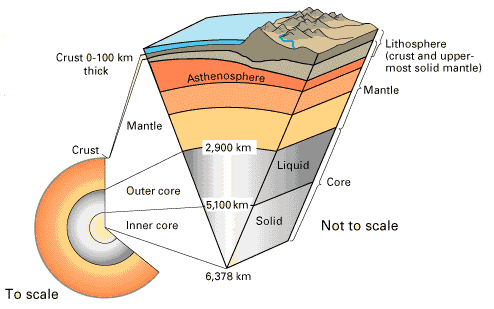A new study has sent ripples throughout the seismological world — a team of researchers from the Australian National University have found a new way to confirm that the Earth’s core is solid.

If you think about it, the very fact that we know so much about the Earth’s interior is stunning. The deepest hole we’ve dug is “only” around 12 km deep, whereas the radius of our planet is 6378 km — so how could we know so much about the Earth’s structure?
Seismic waves
Scientists use many bits and pieces of information to study this structure, but the most important clues come from seismic waves. Whenever an earthquake takes place, it sends out pressure waves in all directions — much like the acoustic waves we use to speak and hear sounds. These waves propagate through the subsurface, reflecting and refracting as they move from one environment to the other. Eventually, they reach the surface, where they are picked up by seismographs — devices that measure the movement of the earth.
Using seismographs, researchers can infer a surprisingly large amount of information. For instance, by measuring the arrival time of seismic waves at different seismograph stations, the position of the earthquakes’ epicentres can be triangulated — this is how we know where earthquakes happen.
But that’s just the start of it.

More than just data about the earthquake itself, we can derive data about the rocks through which the seismic wave has traveled. For instance, generally speaking, there are three types of seismic waves:
- P or Primary waves, which are longitudinal waves (these are the fastest and the first to arrive);
- S or Secondary waves, which are shear waves; and
- Surface waves, which are slower than both P and S waves, but have larger amplitude and more complex movements.

P waves travel through any type of medium, whereas S waves only move through solid environments — not liquid. This was a huge indication that the Earth’s outer core is a liquid, as S waves don’t appear to pass through it. It’s not a liquid in a conventional sense (think of it more like viscous, molten lava, or thick honey), but it’s definitely not a solid.

This also revealed that the inner core is solid, as S waves appear to be able to pass through it. However, the small size of the inner core makes detecting shear waves very difficult, and this theory could still use additional verification. This is where the new study comes in.
J waves
A J wave is nothing more than an S wave that passes through the inner core — seismologists love giving different names to waves depending on where they pass through, but don’t let it confuse you, it’s still a shear, S wave.
J waves are rather elusive because they have small amplitudes, and the Earth’s inner core has a relatively small volume, which means that many seismic waves simply go around it. The small, feeble amplitude is so problematic that detecting J-waves has sometimes been referred to as the “Holy Grail” of global seismology.
However, Associate Professor Hrvoje Tkalčić and PhD Scholar Than-Son Phạm believe they’ve found a new way to identify J waves. What they did is pretty creative: instead of looking directly at the wave as it comes, they simply ignore it for the most part and look at the wave signal hours after the largest rumbles have passed. By studying the similarities between these signals at two receivers after a major earthquake, they’re able to observe a correlation of patterns, and this correlation is the key to the J-wave identification. A similar approach was used by other scientists to study the thickness of Antarctic ice.
“Using a global network of stations, we take every single receiver pair and every single large earthquake – that’s many combinations – and we measure the similarity between the seismograms,” lead author Hrvoje Tkalčić explained.
“That’s called cross correlation, or the measure of similarity. From those similarities we construct a global correlogram – a sort of fingerprint of the Earth.”
“We’re throwing away the first three hours of the seismogram and what we’re looking at is between three and 10 hours after a large earthquake happens. We want to get rid of the big signals,” Dr. Tkalčic added.
Using this approach, they confirmed that the inner core seems indeed solid, though it seems to exhibit some differences from current models. In fact, it’s a bit like two very familiar materials: gold and platinum.
“We found the inner core is indeed solid, but we also found that it’s softer than previously thought,” Associate Professor Tkalčić said.
“It turns out – if our results are correct – the inner core shares some similar elastic properties with gold and platinum. The inner core is like a time capsule, if we understand it we’ll understand how the planet was formed, and how it evolves.”
We should still wait for additional observations to confirm this study but, for now, it seems like the information about the nature of the inner core is becoming more and more solid.
This research was published in Science.


